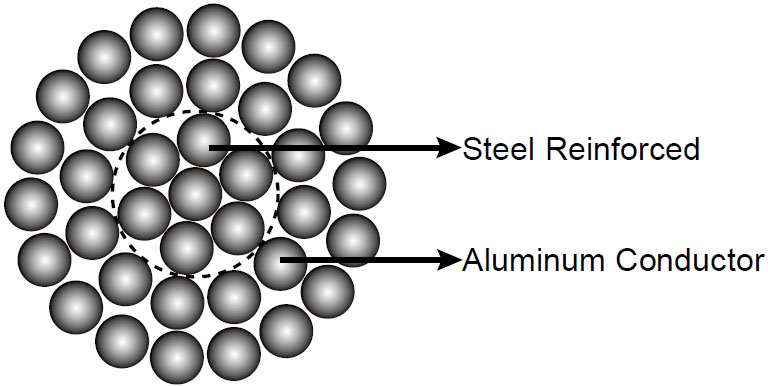ACSR conductors as a common type of conductor, widely used due to their high strength, good conductivity, and various specifications. ACSR conductor wires are extensively used in long-distance power transmission as they are ideal for spanning long overhead lines. They are also used as a support system for overhead cables.

ACSR conductor wires are composed of several aluminum and galvanized steel wires twisted together in concentric layers. The wires forming the steel core are made of galvanized steel, while the outer layer is made of aluminum. The steel core is typically composed of 1, 7, or 19 wires. The diameters of the steel and aluminum wires can be the same or different.
By varying the relative proportions of aluminum and steel, desired characteristics for specific applications can be achieved. Increasing the steel content provides higher resistance to static electricity, while increasing the aluminum content enhances the current-carrying capacity.
High strength: The steel core of ACSR conductor wire provides excellent strength and rigidity, enabling them to withstand high tension and wind loads. This makes ACSR conductors well-suited for long-distance power transmission and spanning large distances.
Corrosion resistance: The aluminum wires of ACSR conductor wires exhibit good corrosion resistance, allowing them to be used in various environmental conditions. The steel core provides additional protection, enabling ACSR conductors to withstand harsh weather and environments.
Low line loss: Due to the lower electrical resistance and higher conductivity of the aluminum wires in ACSR conductors, they experience lower power losses during electricity transmission compared to traditional copper conductors.
ACSR/AW: This type of ACSR conductor has an additional layer of aluminum alloy wires (AW) covering the aluminum wires, providing higher conductivity and corrosion resistance. It is typically used in long-distance power transmission and high-capacity power distribution systems.
ACSR/TW: This type of ACSR conductor has the ability to operate in high-temperature environments, suitable for power transmission and distribution systems that need to withstand high-temperature loads.
ACSR/AAC: This type of ACSR conductor has an additional layer of aluminum alloy wires covering the aluminum wires to enhance conductivity. It is widely used in medium-distance power transmission and distribution lines.
The specifications of ACSR conductors can vary based on specific application requirements. They are typically classified based on wire diameter, the ratio of aluminum wire to steel core cross-sectional area, and the method of wire twisting. Some specific specifications include:
ACSR 336.4 MCM (26/7): This specification indicates a wire diameter of 336.4 MCM, consisting of 26 strands of aluminum wires and 7 strands of steel core.
ACSR 477 MCM (45/7): This specification indicates a wire diameter of 477 MCM, consisting of 45 strands of aluminum wires and 7 strands of steel core.
ACSR 795 MCM (54/7): This specification indicates a wire diameter of 795 MCM, consisting of 54 strands of aluminum wires and 7 strands of steel core.